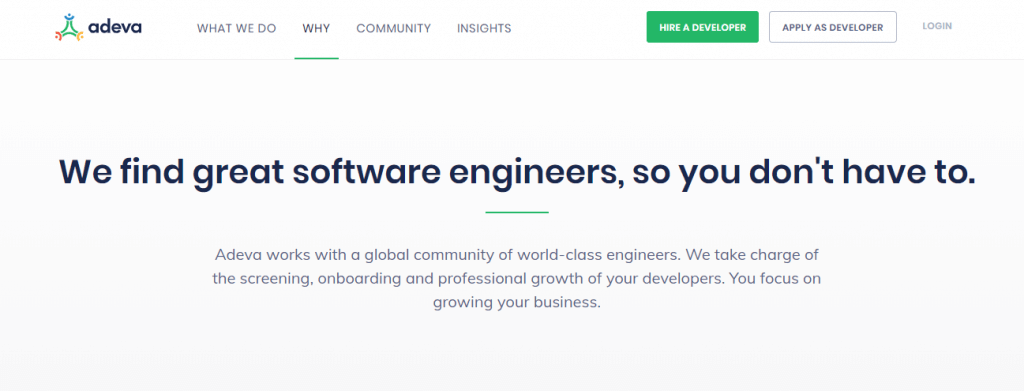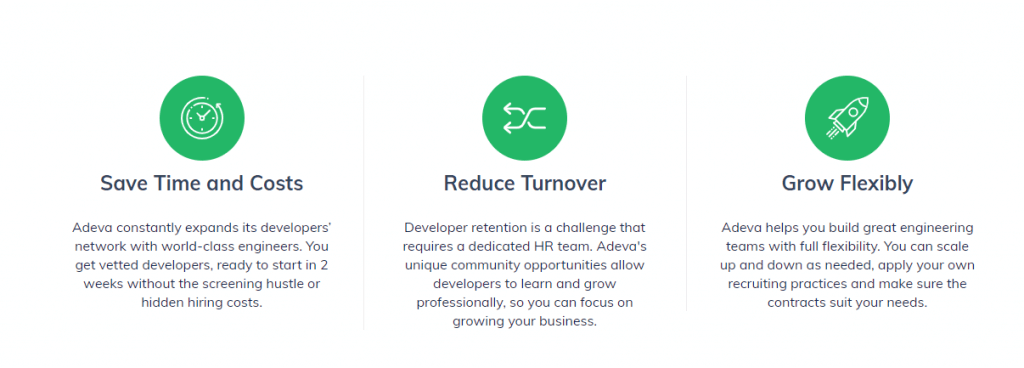Staff augmentation is a powerful strategy for businesses to hire exceptional talent who will help drive the company forward. If you're wondering whether it's the right approach for you, maybe this article will give you the answer you were looking for.
Let's imagine that you're building a tech product with an in-house team of software engineers, but you need to hire a few more to speed up the process. Or, you have one team of engineers building one part of your product in-house and you need to add a few more to your team who will work on developing a different part of the product.
You realize that it's challenging to hire a team of tech experts locally as there's a significant shortage. It would take too long and would be too expensive. What other options do you have?
In recent years, companies of all sizes have been taking advantage of staff and team augmentation arrangements by hiring short-term talent to work alongside their full-time employees. Although a short-term strategy, this approach comes with a set of benefits compared to the traditional alternative of hiring in-house staff.
Here's detailed information on staff and team augmentation, its major benefits, and how you can apply it to your business.
Table of contents
- What is Staff Augmentation?
- Types of Staff Augmentation Services
- What are the Benefits of Staff Augmentation?
- The Most Common Types of Staff Augmentation
- What Is the Difference Between Staff Augmentation and Managed Services?
- When Is Staff Augmentation the Suitable Approach?
- How to Make the Most of Staff Augmentation Services?
- Key Takeaways
What is Staff Augmentation?
The staff augmentation meaning is the following:
A type of flexible strategy that helps businesses hire the talent they need. It's the process of hiring external talent to work as part-time contractors or full-time as part of a company.
By applying engineering staff augmentation, companies can close the knowledge gap, speed up their time to hire and time to market, and access highly qualified software developers.
By embracing open communication, clearly defining roles, using project management tools, and supporting documentation-driven development (DDD), companies can reach milestones faster and build their products on time.
Types of Staff Augmentation Services
There are different ways of engaging staff augmentation talent. The most popular include:
- Gig platforms. Gig platforms such as Upwork or Guru are online platforms that provide quick access to talent from around the globe. You can hire freelance software engineers on an hourly or fixed-price rate. To make sure you're hiring a professional, these platforms let you rate developers and leave reviews.
- On-demand talent platforms. On-demand platforms such as Adeva are a community of developers that take care of sourcing, screening, and onboarding software engineers for you. They have access to skilled developers in a range of technologies and various seniority. Depending on their availability, you can hire developers part-time or full-time. Each engineer goes through a thorough vetting process. Their skills are triple-vetted with the help of various aptitude and personality assessments. If they pass the vetting process, these engineers will work as part of your team as distributed team members. They will follow your staff augmentation best practices, use your tools, and attend your daily standups.
- Independent contractors. To hire an independent staff augmentation contractor, you don't go through a third-party platform. The developer of your choosing needs to be directly contacted by you, and terms should be discussed between you and the developer. When working with independent contractors, you need to make sure you have strong hiring criteria and be prepared to take the risk if something goes wrong with the contractor.

What are the Benefits of Staff Augmentation?
Access to highly qualified engineers
As a result of the rapid growth of artificial intelligence and automation, many businesses today suffer from a lack of talent who can bring their creative ideas to life. But by hiring external talent, companies can bridge the skills gap. You're no longer limited by a single zip code. The entire world becomes your talent pool. You can hire smarter, faster, and more cost-effectively.
Reduced costs for recruitment
There's no need for you to spend money on expenses such as office space or work equipment. You only create an account on a platform like Upwork or pay a fee to a staff augmentation firm, and they will take care of arranging everything. You'll have more time to focus on your core business tasks.
Increased flexibility
When you hire external talent, it becomes easier to upsize or downsize the team. You can hire talent on a short-term contract in case the project demands expand. By doing so, you won't have to waste time and money hiring full-time employees and laying them off when the project ends.
Fast project execution times
Almost every IT project has deadlines for delivery, so a staff augmentation project can help a great deal. If you're struggling to meet those deadlines, then staff augmentation might help you meet aggressive deadlines by speeding up your project execution times. You'll manage to welcome high-quality engineers on your team team augmentation Agile quickly and allow your company to thrive.
The Most Common Types of Staff Augmentation
There are three main types of staff augmentation: commodity, skill-based, and highly skilled.
Commodity staff augmentation doesn't involve hiring highly specialized talent. It has more to do with urgency and filling out positions such as manual labor, factory work, or retail.
Skill-based staff augmentation involves hiring talent with certain skills, but the level of skills is not critical. Basic copywriting, typing, or data entry are a few examples of skill-based staff augmentation.
Highly skilled staff augmentation involves hiring people who possess advanced skills in professions like software development and IT. The level of skill in this type of staff augmentation is critical.
What Is the Difference Between Staff Augmentation and Managed Services?
The staff augmentation model is the approach where companies personally choose the workers and manage them with the methods and tools of their own choice. On the other hand, with the managed services approach, the project outsourcing company deals with structuring the team and managing all processes.
An augmented staff member might be added to a team for a limited time to write lines of code for a certain application and be paid hourly. A managed service contractor would be hired to create that specific application and meet a set of KPIs. They're often paid upon the completion of the project.

When Is Staff Augmentation the Suitable Approach?
As attractive as it seems, staff augmentation is not the right method for all types of scenarios. You need staff augmentation if:
- The project is short-term. Long-term projects take months to complete, and in that case, the smarter option is to hire a long-term, full-time worker.
- You need specialists with a specific skill set to complement your existing augmented team.
- Your project is of low or medium complexity. A staff augmentation model may not be suitable for complex projects that involve a lengthy ramp-up time.
- You already have developers working on your product in-office. However, you want to put together another engineering team of a few skilled gig workers to work on developing a different component of the product.
How to Make the Most of Staff Augmentation Services?
Maintain clear and open communication
According to the State of Remote Work 2019 Report by Buffer, 17% of distributed employees are struggling with collaborating or communicating. Clear communication is critical to the development process of any project, no matter if it's in-house or remote. For ongoing communication with your team, you can use tools such as Slack, Trello, or Asana. A vital tip to remember is always to have face-to-face communication, at least bi-monthly. Great video conferencing tools are Google Hangouts and Zoom.
Clearly define job roles
If you want to clearly define staff augmentation, you'll have to define the job roles. Make sure every person on your team knows what their job entails. They should be informed of their day-to-day tasks and responsibilities. Tell them what's expected of them and how you will measure their job performance. Don't skip to appointing project or team leaders who will ensure each member of the team performs their tasks on time and expertly.
Use project management tools
Staying up-to-date with projects and moving forward in an orderly manner when you have a distributed team can be challenging. In these scenarios, you must create procedures and use appropriate project management tools to keep the whole team in sync.
There are several remote project management tools that many teams are using to keep track of the progress of each project. The most popular are Jira and Trello.
Jira is more suitable if you're managing a complex project that includes a lot of dependencies between tasks. On the other hand, Trello is a simpler project management tool and ideal for smaller teams.
Support documentation-driven development
Finally, structuring team knowledge is vital. For this, it's a good idea to use tools like Google Drive, GitHub wikis, or Confluence pages for documenting your processes.
Key Takeaways
To wrap up:
- Now you know what augmentation is, a type of flexible outsourcing strategy that helps businesses hire the talent they need.
- There are different ways of engaging staff augmentation talent. The most popular include gig platforms, on-demand talent platforms, and independent contractors.
- The major benefits of staff augmentation include access to high-quality talent, reduced recruitment costs, increased flexibility, and fast project execution times.
- As attractive as it seems, staff augmentation is not the right method for all types of scenarios.
- In order to make staff augmentation work for your company, you should encourage open communication, clearly define job roles, use appropriate project management tools, and support documentation-driven development.


